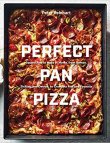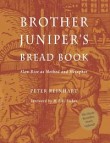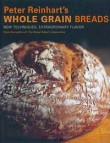Peter’s Blog, Sept. 15th, Cold Fermentation
He’s raised an interesting question: does long, cold, overnight fermentation create a flavor that would universally be considered superior; that is, an inarguable benefit? To answer this, I think, requires more than a simple yes or no, but an explanation as to what happens during the fermentation stage that would lead to the opinion that this is a way to improve flavor. We’ve discussed this here in the past, though in an abbreviated manner, so let me draw it out more completely and, hopefully, address Scott’s question at the same time.
My belief (and remember, this is just my opinion — no one owns the whole truth in these matters) is that the key to the value of long fermentation is the enzyme activity, in particular the alpha-amylase and beta-amylase action that slowly releases glucose, maltose, and other sugars from their starchy chains in the flour. This takes time, anywhere from 6 to 12 hours minimum, but it is not a biological fermentation since enzymes are not alive, they are simply part of the grain (protein fragments, but not living organisms, if I understand the chemistry of them properly, but then I’m no chemist). The process of sugar break-out from the starch is slower at colder temperatures but is not subject to the same rules as yeast and bacteria (which essentially go nearly dormant when they get cooler than 40 degrees F.). Anyway, pizza makers have known for a long time, whether by accident or intentionality, that their dough balls are better tasting and more beautiful to look at when used the following day (or even over a number of days, within reason) than if used on the same day in a fast rising method. It is not only because the fermentation is better in the slow method but, I believe, because more natural sugar has been evoked from grain by the enzymes and that improves both color and flavor, as well as providing new, ongoing food for the yeast and bacterial fermentation (so, in a way, it does elicit more fermentation flavor as well as releasing sugar). Bottom line: yes, Scott, I do believe long, cold fermentation improves flavor but, I have to say this too, it is not the only way to release flavor — that is, it is time more than coldness that is the key.
I say this because, as we discussed in the long comment thread a few weeks ago, Philippe Gosselin (and I’m sure others) uses a method that doesn’t require any yeast during the overnight period and, more importantly, pizza masters like Chris Bianco are able to achieve amazing flavor and texture by making their dough on the same day, not using any refrigeration. But in Bianco’s case, and others who can pull it off, the dough is made early enough in the day to allow the enzyme activity to occur without over-fermenting the dough by using a smaller amount of yeast. In other words, the “baking triangle” consisting of time, temperature and ingredients can be manipulated in many ways to achieve great results. Some methods and formulas might, for example, use a pre-ferment like a biga, poolish, or pate fermentee’ to add enzyme-evoked flavor in a shorter period of time.
So, to summarize, Scott123 is correct in asserting that long, cold fermentation achieves superior results to short, fast fermentation but let’s not forget the possibility of long, room temperature fermentation too, or the use of pre-ferments to shorten fermentation time (I won’t even touch the matter of commercial dough conditioners that spike the dough with added enzymes to speed things along — that’s another can of worms but one worth visiting in the future). If I’m not mistaken, Jim Lahey uses the room temperature method in his so-called “NY Times French Bread” method (and I believe also in his pizza dough — BTW, I think we should stop calling it the NY Times method and let Jim have it named after him, the Lahey method — I’m okay with that since he’s the one who first brought it to light and Jim is a good guy!). The fact that his French Bread dough sits overnight before going into a hot Dutch oven is for convenience more than because it is “overnight” — you could mix it in the morning and bake it at night just as easily; it is time, that very critical point on the baking triangle, that affects the flavor, as long as it is properly balanced by the other two corresponding points (ingredients = small amount of yeast; temperature = either cold or, possibly, ambient room temperature). For a pizzeria, though, it makes sense to work a day or two ahead for any number of reasons and, from what I observed at Pizzeria Bianco, it may simply be a matter of lack of space and refrigeration that necessitated the ambient method rather than a philosophical or anti-cold fermentation dough method. That is, we can almost always make the situation work to our advantage if we keep the three points on the “baking triangle” in the proper balance.
Okay, that’s my take on it — what do you all think?
Recent Articles by Peter Reinhart
- Peter Scott Ruben: Why Frank Sinatra is the true “Chairman of the Board,” and the Greatest of the Greats
- Elizabeth Brasch, Mellow Mushroom’s Has a Vision
- Nipun Sharma: Pizza’s A-I Robotics Future is Now
- Maui Pizza with Chef Jeff Scheer of Restaurant Marlow
- The Pizza Yodi’s Are Back –John Arena and Brian Spangler are in the House!
- Arthur Bovino and Alfred Schulz and Their Pizza Pod Party
Add Comment
You must be logged in to post a comment.










Thanks Scott and also to all who have replied to this thread. I think I have said all along that to “evoke the full potential of flavor trapped in the grain” (what I dubbed The Baker’s Mission), it is important to properly ferment the dough and that time is an overlooked but essential ingredient. So, if you are asking if I’ve been unfair to those who use short fermentation (I’m not sure how to interpret your question because it can be taken two ways) by implying that they are making an inferior product I can only say that the proof is in the pizza. If you are asking whether I ought to be more vehement in asserting the superiority of long, slow fermentation, I think the sub-title of my first book, “Brother Juniper’s Bread Book,” says it all: [b]Slow Rise as Method and Metaphor.” [/b]
Now, let’s move on to a new topic. Whoever poses the next exciting question here at the end of this thread gets to be the spark for my next Peter’s Blog. If a few good ones come in I’ll be tie breaker.
Over on TFL I see lots of people slavishly following very exacting instructions without understanding what the instructions are intended to convey. Perhaps Peter could attempt to articulate the difference between importance and exactness or in some way provide some useful guidance to set expectations a little lower with respect to the behavior of sourdough cultures in the amateur’s kitchen. There is the “you have to do it enough times to have seen it go wrong occasionally” method of teaching, and there is the parametric sensitivity derivatives analytic approach which is find for the science crowd but pretty useless for the average home baker. Is there a happy medium?
I came upon this post because I’m looking for the difference between two recipes. I have Crust & Crumb in hand, but heard great things about American Pie. Midway through the basic C&C pizza dough recipe, I looked at the web-based AP Napoletana recipe, and was surprised at how different it was. I would think American Pie would trump, being pizza-focused and all, but Crust and Crumb came out the year *after*…
Any thoughts on the differences?
(C&C has a poolish, a 3 hr RT rise, fridge overnight, then shaping. AP uses chilled H2O & flour (?), shaped, then overnight in the fridge.)
lfstewart: you are mistaken on the timeline. C&C 1998, BBA 2001, AP 2003.
Ah, thanks Jared! I had just been going by what Amazon had.